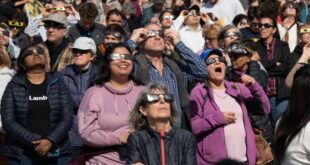European Space Agency’s Euclid telescope aims to create largest 3D map of universe.
Dark matter and dark energy make up roughly 95 per cent of our universe but can’t be seen. In order to reveal their influence, over its six-year mission, the Euclid space telescope will observe the shapes, distances and motions of billions of galaxies out to 10 billion light-years and create the largest cosmic 3D map ever made. Below are five of the first images from Euclid released by the European Space Agency.
Euclid shows us a spectacularly panoramic and detailed view of the Horsehead Nebula, also known as Barnard 33, which can be found in the constellation Orion. In Euclid’s new observation of this stellar nursery, scientists hope to find many dim and previously unseen Jupiter-mass planets in their celestial infancy, as well as young brown dwarfs and baby stars.

(ESA/Euclid/Euclid Consortium/NASA; Image processing by J.-C. Cuillandre [CEA Paris-Saclay], G. Anselmi)
This incredible snapshot from Euclid is a revolution for astronomy. The image shows 1,000 galaxies belonging to the Perseus Cluster, and more than 100,000 additional galaxies farther away in the background. Many of these faint galaxies were previously unseen. Some of them are so distant that their light has taken 10 billion years to reach us. By mapping the distribution and shapes of these galaxies, cosmologists will be able to find out more about how dark matter — invisible mass exerting a huge gravitational pull on a galactic scale — shaped the universe that we see today.

(ESA/Euclid/Euclid Consortium/NASA; Image processing by J.-C. Cuillandre [CEA Paris-Saclay], G. Anselmi)
Over its lifetime, Euclid, what the European Space Agency has dubbed a ‘dark universe detective,’ will image billions of galaxies, revealing the unseen influence that dark matter and dark energy have on them. That’s why it’s fitting that one of the first galaxies that Euclid observed is nicknamed the ‘Hidden Galaxy,’ also known as IC 342 or Caldwell 5. Thanks to its infrared view, Euclid has already uncovered crucial information about the stars in this galaxy, which is a look-alike of our Milky Way.

(ESA/Euclid/Euclid Consortium/NASA; Image processing by J.-C. Cuillandre [CEA Paris-Saclay], G. Anselmi)
This sparkly image shows Euclid’s view of a globular cluster called NGC 6397. This is the second-closest globular cluster to Earth, located about 7,800 light-years away. Globular clusters are collections of hundreds of thousands of stars held together by gravity. Currently no other telescope than Euclid can observe an entire globular cluster in one single observation, and at the same time distinguish so many stars in the cluster. These faint stars tell us about the history of the Milky Way and where dark matter is located.

(ESA/Euclid/Euclid Consortium/NASA; Image processing by J.-C. Cuillandre [CEA Paris-Saclay], G. Anselmi)
*****
Credit belongs to : www.cbc.ca
 Atin Ito First Filipino Community Newspaper in Ontario
Atin Ito First Filipino Community Newspaper in Ontario






